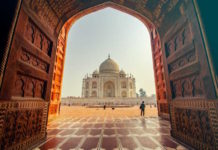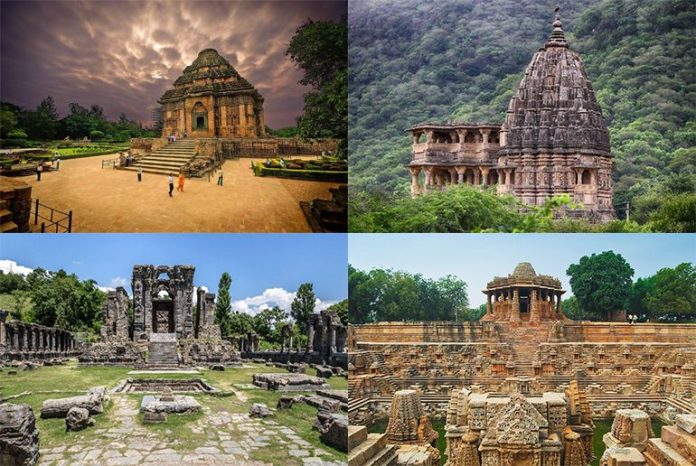Religion means a thousand words which one cannot perceive in a single manner since it is learnt from ages, The religions all over the globe are so diverse that it gave birth to amazing structures called temples. Temples have been built for ages and many new ones open their doors every year. However, these ancient temples the list below were built millenniums ago by people whose religion and belief system are no longer practised. These masterpieces are among the oldest man-made structures found on earth that are the true symbols of our glorious- past and present.
There is a number of temples which can be stated as pillars of the cultural and religious India on the whole, since still people follow the religious era, and even practice the norms of the Hindu mythology, and visit the famous old temples and try to track the epics and history related to the temples.
- Brihadeshwara Temple, Tanjore, Tamil Nadu
This temple is built by King Chola in 1002 AD, this temple is a masterpiece of South Indian architecture, and is dedicated to Shiva, is the finest example of Dravidian art. This is a blend of temples, architecture and valuable allied arts. The shrines are gold plated and the sculptures are interconnected within and have a large hall within which resembles as other spectacular attraction of this place which makes this temple among the popular oldest temples of India.
- Jakhu Temple, Shimla
This temple is dedicated to Lord Hanuman and is an ancient masterpiece and it is believed that this temple holds the footprints of Lord Hanuman. It is located on the Jakhoo Hill, which is 2.5 km from the Ridge and offers beautiful views of the Shivalik Mountains and the nearby town of Sanjauli. It is the highest peak in Shimla and gives shelter to countless playful monkeys which can be found waiting to be fed by visitors.

To visit this temple visitors take a cable car ride known as Jakhu Ropeway Shimla, which sometimes they pre-book online through jakhuropewayshimla.com during peak season.
This temple of Lord Hanuman, the most faithful aide to Lord Rama is located in the thick forests of Jakhu hills. The devotees need to cover a steep hill trek of around 2 km to reach the temple. The temple can also be visited on the back of ponies that are available on hire at the base of the hill.
- Siddhivinayak Temple, Mumbai
The three Siddhivinayak temple is a Hindu temple dedicated to Lord Ganesh in Mumbai. The engravings and carvings create a magnificent masterpiece with an expressionist architecture. Lord Ganesha is the supreme deity of the temple and is famous for being the first to worship to commence any new project or construction, hence it is known as Vighnaharta. On the wooden doors of the shrine, eight impressions of Lord Ganapati (Ashtavinayak) are carved. Siddhivinayak temple consists of one of the eight images of the God. Other distinct images are spread over seven temples situated in Maharashtra.
4. Dilwara Temple, Mount Abu, Rajasthan
Located about 2.5 km from Mount Abu, each of these five temples are unique in their own way and were built between the 11th and 13th century AD and are remarkable for their stunning use of marble. These five temples (Vimal Vasahi, Luna Vasahi, Pittalhar Temple, Parshvanath Temple and Mahavir Swami Temple) are considered the most beautiful Jain pilgrimage sites in the world.
5. Orchha Temple, Madhya Pradesh
Orchha is another famous tourist spot located near the famous Khajuraho Temple. The town has Chaturbhuj Temple, Lakshmi Temple and Ram Raja Temple.
The Chaturbhuj temple is imposing with tall spires built atop a high platform. Its exterior is richly ornamented with lotus symbols. The Raja Ram Temple resembles a palace as the Ram is worshipped as a king here.
The Lakshmi Temple is an odd mixture of temple and fort and a unique mixture of concentric forms. It consists of an octagonal central tower inside a triangular temple. In line with this eccentricity, the entrance gate is set in a corner rather than the wall.
6. Manu Temple, Manali
Named after the holy Sage Manu, the Manu temple in Manali is one of the prime attractions among religious sites of Manali. As per Hindu mythology, Sage Manu, the divine creator of the human race, dwelt and meditated in Manali. Considering a belief like this, Manu temple was built right at his meditative spot. Owing to such tales, the temple holds a great amount of significance for the pilgrimage.
This Pagoda style of structure offers quite a glimpse into history, spirituality as well as a fascinating style of architecture.
7. Konark Sun Temple
This temple is an architectural marvel of eastern architecture, which is known as the Sun Temple. This temple is dedicated to Sun God. Every inch space of this huge masterpiece has been carved with beautiful carvings which sheds a perfect scenic beauty which makes the architecture spectacular and marvellous.
Konark is an exceptional mixture of marvellous temple architecture, heritage, exotic beach and salient natural beauty. The large structure of Konark Temple seen today is actually the entrance of the main temple. The main temple which enshrined the presiding deity has fallen off and only the remains can be seen. Even in its ruined state, it is a magnificent temple reflecting the mastermind of the architects that imagined and constructed it.
8. Kashi Vishwanath Temple
This temple is one of the most popular Hindu Temple dedicated to Lord Shiva. It is the heart of Varanasi and it is a core of faith of millions of Hindus. The main deity of Kashi Vishwanath Temple is Lord Shiva, also known as Vishwanatha or Vishweshwara meaning ‘the ruler of the universe’. The temple also houses several other small temples such as Kaalbhairav, Vishnu, Virupaksha Gauri, Vinayaka and Avi Mukteshwara. It is believed that the one who will take bath (at least once in the lifetime) in the Ganga in the holy city Varanasi will get Moksha. True devotees of Lord Shiva get freedom from the cycle of the death and birth. After death, they directly intermingled into the Mahadev. People believe that the one who decided to end their life at the temple, Lord Shiva himself drive a mantra of freedom in his ear.
9. The Golden Temple, Amritsar
The legendary Golden Temple is actually just a small part of this huge gurdwara complex, known to Sikhs as Harmandir Sahib. Spiritually, the focus of attention is the tank that surrounds the gleaming central shrine – the Amrit Sarovar, from which Amritsar takes its name, excavated by the fourth Sikh guru, Ram Das, in 1577. Ringed by a marble walkway, the tank is said to have healing powers, and pilgrims come from across the world to bathe in its sacred waters. The Golden Temple itself is a mesmerising blend of Hindu and Islamic architectural styles, with an elegant marble lower level adorned with flower and animal motifs in pietra dura work.

10. Vaishno Devi Temple, Jammu & Kashmir
A pilgrimage to the Holy Shrine of Shri Mata Vaishno Devi Ji is considered to be one of the holiest pilgrimages of our times. Popular the world over as Moonh Maangi Muradein Poori Karne Wali Mata, which means, the Mother who fulfils whatever Her children wish for, Shri Mata Vaishno Devi Ji resides in a Holy Cave located in the folds of the three peaked mountain named Trikuta (pronounced as Trikoot). The Holy Cave attracts millions of devotees every year. In fact, the number of Yatris visiting the Holy Shrine annually now exceeds one crore. This is due to the unflinching faith of the devotees who throng the Shrine from all parts of India and abroad.
The Holy Cave of the Mother is situated at an altitude of 5200 ft. The Yatris have to undertake a trek of nearly 12 km from the base camp at Katra. At the culmination of their pilgrimage, the religious believers are blessed with the Darshans of the Mother Goddess inside the Sanctum Sanctorum- the Holy Cave. These Darshans are in the shape of three natural rock formations called the Pindies. There are no statues or idols inside the Cave.
















